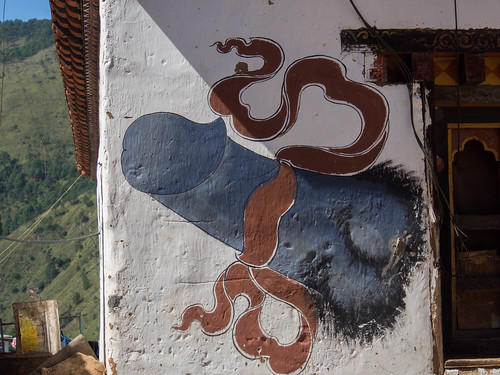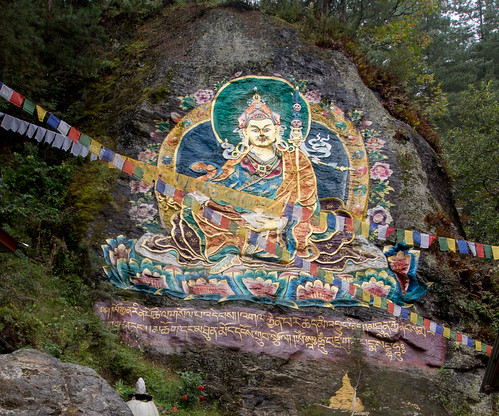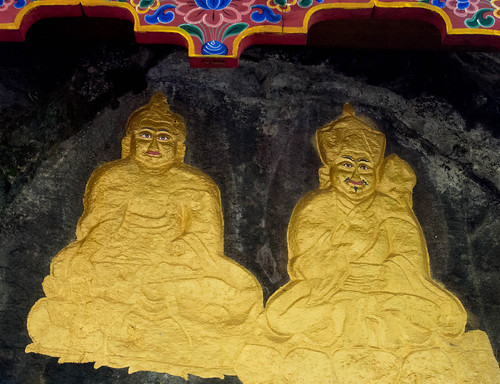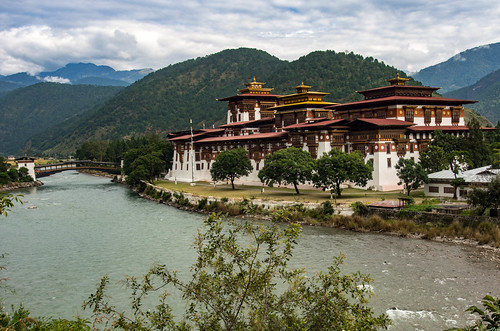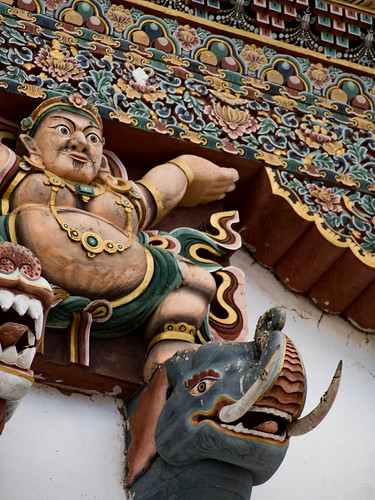You are currently browsing John Halbrook’s articles.
The adventure began with an e-mail, as so many events do these days. My wife is on the mailing list for retirees of the World Bank and when a trip to Bhutan appeared on the radar screen, she was good enough to forward it to me. She couldn’t go because of work and other constraints, but knew that it would be difficult for me to resist. Since I am the chief cook and bottle washer and the only driver in the family, that was quite a sacrifice. Bhutan has been at the top of my list since the fourth King decreed that the goal of his government would be “gross national happiness.” GNH is a pretty fuzzy concept, but it implies a commitment to environmental sustainability, cultural preservation and some degree of civic contentment. The government does appear to take it seriously. Surveys are undertaken yearly and attempts are put in place to redress problems. It stands in stark contrast to my homeland’s perverse pursuit of gross national misery for its poorer citizens combined with a casual disregard for the well-being of others.
In 2006, the fourth king, Jigme Singye Wangchuck, stunned his people by by bringing Bhutan’s absolute monarchy to an end, drafting a constitution and instituting free elections. The country now enjoys free health care and education. Infant mortality has been halved since 2000. Poverty has fallen by 90% and incomes have tripled. The Asian Development Bank expects the GDP to grow by 6.4% this year. The landlocked Himalayan kingdom of 750,000 had no paved roads before 1961, no commercial airport until 1983, and no telephone network until 1999.
There are growing pains, however. In response to uprisings in the late eighties and early nineties, the King expelled one hundred thousand of its citizens, nearly all of them Hindus of Nepalese origin, forcing them into refugee camps in eastern Nepal. The law now mandates that all Government workers and school children must wear traditional dress and all new buildings must be built in the traditional style. Most of the populace still work the land as subsistence farmers, but Thimphu, the Capital, is growing very quickly, inflating the prices of houses and apartments. The city buzzes with cars, stray dogs and tourist shops and even houses drug rehab clinics. Still, so far, it bears no resemblance to Kathmandu.
The previous cap of five thousand tourists a year has been lifted and the country is currently seeing over one hundred thousand. For the last two years, the the East-West highway has been undergoing a major upgrade to turn a one-lane road into a two-lane highway, all the while keeping traffic moving despite the ever present danger of rock slides caused by monsoons and the road work itself. Much of the construction has been contracted out to India which subsidizes the country’s coffers substantially through the purchase of hydroelectricity. Bhutan’s relations with its northern neighbour are understandably wary, given the invasion of Tibet and China’s attitude toward Buddhist leaders.
Our journey to Bhutan took advantage of one of the major festivities on the Bhutanese calendar— the “tshechu festival” in Thimphu. Bhutan is the only country in the world whose state religion is Vajrayana Buddhism. The festival is dedicated to Guru Padmasambhava, the Tibetan master who who brought Buddhism to Bhutan. The Bhutanese people dress in their finest and attend the events to get together with friends and family and to gain merit for the next life. The dances and rituals are performed to honour the revered Rimpoche, to solidify the precepts of Buddhism and to foster sense of social cohesion, harmony and belonging.
Visiting Bhutan today requires an expenditure of $250 US per diem in a group and somewhat more for solo travelers and couples, but that sum includes food, accommodation and a guide. All temples and dzongs (fortified castles that house religious and secular administrators) are off-limits unless one has a Bhutanese guide in tow. The Nepalese organizer of our tour enlisted the services of a guide, an assistant a very skillful driver and luggage driver. Once we saw the condition of the National Highway, our gratitude to these men knew no bounds. Our visit to Bhutan would take us from the Western town of Paro to the ancient capital of Bumthang and back again. We would cover about a thousand kilometers, sometimes at a snail’s pace, sharing jokes and personal stories, food, tea, beer, bath houses and some pretty good whiskey.
Oh, and not to mention, phalluses.
Even the well-endowed visitor to Bhutan might feel a bit insecure at the sight of a six foot penis on the side of a house. To appreciate the proliferation of public phalli throughout the country, you have to know about Drukpa Kunley (1455-1529), otherwise known as the Divine Madman. He arrived from Tibet in the 15th century, challenging Buddhist convention, its trappings, its reverence for celibacy and abstinence of all kinds. He was known for his crazy methods of enlightening other beings, mostly women, which earned him the title “The Saint of 5,000 Women”.
Kunley was part of a tantric lineage established by the master Tilopa, in the 9th century. He was at odds with logic, morality, and the hierarchical religious order of the day. “Outwardly,” Kunley said, “I live for my pleasure and inwardly I do everything in the right moment. Outwardly I am a ragged beggar and inwardly a blissful Buddha.” Part of his influence was no doubt due to his reputation as a fearless slayer of demons and powerful evil spirits, which were believed to be prevalent in the mountainous regions of Bhutan. Barren couples from around the world still visit Chimi Lakhang, the small temple built to honor Kunley. They receive blessings and get a name for their child.
In a country that is rapidly moving into the 21st Century, the Tibetan iconography that decorates dzongs, temples and even the landscape baffle the uninformed Western visitor. It deserves the creation of a new phrase altogether— magical surrealism. This year marks the 400th anniversary of Bhutan’s creation as an independent state, but it is also the most auspicious point in the sixty year cycle of Bhutanese astrology— the year of the Fire Male Monkey. There are protective deities and evil spirits, emanations and incarnations, pictorial representations of ignorance, greed and anger, past Buddhas, present Buddhas future Buddhas and all the Boddhisatvas, those who put off their own enlightenment in order to help others become enlightened. Guru Rimpoche alone has twelve manifestations.
Our guide seemed to regard the flight of Guru Padmasambhava to the side of a steep cliff on the back of a tigress as a simple bit of Bhutanese history. According to legend, the tigress was an emanation of his consort and the Precious Guru flew there to subdue negative spiritual forces hostile to Buddhism He meditated there for three months and left his imprint in rock. The fact that that the cliff-edge temple (depicted in my first photo) has burned down and been rebuilt twice (the last time only thirty years back), is remarkable, considering the challenging nature of the trail leading up to the site. Events that date from the seventh century seem to collide with recent history; the Second Buddha’s rebirth as fresh as the recent birth of the male heir to Jigme Wangchuck, fifth in the line of Dragon Kings. To the ignorant layman, it is all a bit confusing.
Our group was predominately female, well-traveled and well-educated,witty and fun, intent on reaping the rewards of visiting a country as remote and fascinating as Bhutan. Needless to say, there were some choice comments about the stylized depictions of male members we encountered along the way. From Thimphu, our route took us East to the ancient capital of Punakha, with its stunningly beautiful dzong situated between two rivers, male and female.
We climbed over a pass of eleven thousand feet, then zig zagged down steep mountainsides toward raging rivers. In addition to spectacular waterfalls, mountain slides and road workers, we encountered yak, horses and cyclists. Mountain biking has become something of a passion in Bhutan since the fourth king took it up seriously after retiring in favour of his son. Seven years ago, the Bhutan Olympic Committee organized the Tour of the Dragon, a 268 km race from Bumthang to Thimphu crossing four mountain passes from 4000 to 11000 feet. In places the road stretches uphill for nearly for 38 kms. The organizers boast that it is one of the most difficult one-day races on Earth.
Last year’s top finisher pedaled the Tour in thirteen hours and two minutes which may be faster than the time we took to travel the same route in a bus. It is not surpising that the results were better in 2014, before the road work began. The promotional material states that: “On the road, with almost gentle gradients, one can reach as high 4000m or 13000ft, starting from 2300m or 7500ft, in a span of just 2 hours. In these 2 hours, you see temperate zones settlements and meet semi-nomadic herders in their yak camps living in alpine conditions. You can climb from deep river valleys to high mountain passes and see perennially snow-clad mountains, after having gone through uninterrupted forests — from cool broad-leaved forest to the shrubs of the tree line….And once you have left Thimphu, where most of the nearly 50,000 vehicles are found, you have the roads virtually to yourself.”
If that sounds tempting, there is still time to sign up for 2017. It starts September 2nd at 2 AM.
There are flags and chortens everywhere. The flags all have religious significance and there are different colours for different locations. Prayer flags flutter on mountain passes, rooftops, in dzongs and temple courtyards, in front of houses and hotels. Five colours – blue, green, red, yellow and white – symbolise the elements of water, wood, fire, earth and iron, respectively. They also stand for the five dhyani (meditation Buddhas); the five wisdoms; the five directions; and the five mental attributes or emotions. Chorten is the Tibetan word for stupa, which is a receptable of offerings, generally erected at crossroads. In Bhutan, a simple rectangular structure is surmounted by a tower and spire.
An astonishing array of plants grows in Bhutan. There are over five thousand species, including six hundred species of orchids and forty-six varieties of rhododendrons. Glaciation had no impact on the lower reaches of the Himalaya, so some plants can be traced back to before the ice age.
The town of Trongsa lies at the geographic centre of the country. It was home to the first and second kings of the Wangchuck dynasty. Perched on a cliff, the Chotse Dzong is the largest and most impressively situated in Bhutan. We were fortunate to be present for a celebration of a recent election, when the representatives and their supporters gathered in the courtyard of the dzong in the their finest clothes and footwear.
The region of Bumthang is regarded as the cultural heart of Bhutan. There is a rich diversity of traditions that predate the unification of the country in the 17th century. Four rivers flow through broad valleys. The main crops are buckwheat, barley, rye, potatoes and apples. In Jakar, a local brewery and cheese maker from Switzerland caters to the tourist trade. An old palace is being restored as a museum and a brand new temple has just been built. It is a Nyingmapa temple, an ancient branch of Buddhism that depends on private donations rather than government subsidies.
The final stop on our tour of the country took us south into the Phobjika Valley, renowned as the winter destination of the black-neck cranes. It is also home to the Gantey monastery, another Nyingma institution. The lovely landscape is expansive, a wide, glacial valley within the Black Mountains, a natural habitat for wild boar, black bears, leopards, deer and foxes. It is the location of the second photo in this essay, at the end of a lovely walk up to the monastery. Despite the long and tortuous road trip, we left the Valley exactly one day before the very first crane cruised into its winter home. Fortunately, a wounded bird was being rehabilitated at the Black-Neck crane centre and we were able to see one of the majestic birds up close. We were of no interest to the beautiful bird.
It has taken awhile to go through fifteen hundred fifty photos and write up this post for “Down Under,” which has suffered from serious neglect for some time now. Please click on any of the photos running alongside the post and you will be transported to Flickr, where you can see the Bhutan album in addition to the one from Kathmandu. Enjoy.
This is the last post I wrote about Western Australia, a part of the continent that often escapes the tourist traffic thanks to its distance from the East Coast. It is definitely worth an extended stay.
The morning of our return flight from Exmouth to Perth, I got a text message followed by a call on my mobile (cell phone). The departure was going to be delayed by four hours. We had planned to arrive at Perth airport at 3:30 in the afternoon, allowing us enough time to pick up our rental car and drive to Margaret River before dark.
When we drove past the airport on our way into Exmouth to gas up, I saw the plane on the tarmac. There had been no explanation for the delay, but I would not be surprised if it had something to do with a certain offshore oil rig. I phoned the owner of the B&B in Margaret River and the car rental company about the delay, but when we finally arrived in Perth, the Thrifty agent had disappeared. It took a good half hour to round her…
View original post 401 more words
When we booked our flight to Exmouth, I assumed we would be boarding a small plane. I was hoping the aircraft would be post WW II, and that the pilot wouldn’t have to start the engine by spinning the propeller. My error was in assuming that tourists would make up the majority of the passengers. It turned out the SkyWest flight was a shuttle service for off-shore oil workers. In the two hours it took our packed plane to reach its destination, I learned more about tools for oil rig work than I ever wished to know. The airport for the town is located 37 kms south of town, which makes the drive south to Coral Bay a reasonable two hour run.
I was dismayed to discover that I would have return the car with something approaching a full tank of petrol. This meant driving back past the airport and…
View original post 596 more words
I wrote this up in 2009, but it is mostly history, so I doubt if any of it will seem dated seven years later.
The notion of returning to Western Australia one month after my trip to the Kimberly seemed crazy on the face of it, but my wife had vacation time coming and she had been impressed by my enthusiasm for W.A., as it is called here. She was keen to see the Margaret River area just south of Perth, the state capital. It is renowned for its wineries, tall trees and a spectacular coastline.
When I began putting the trip together, we toyed with several side trips, narrowing it down in the end to Perth, Margaret River and the Ningaloo Reef up north. We would fly to Perth, stay a couple of days, then catch a local airline up to Exmouth to snorkel in the Indian Ocean at a place called Coral Bay. A mid afternoon flight back to Perth would give us just enough time to drive down to Margaret River…
View original post 684 more words
The last of the Kimberley posts. I’m sorry to leave this particular landscape behind. I wish I had plugged more pics into the text, but at the time, the pics on Flickr (to the left of the text) all corresponded to the words.
The Great Northern Highway is the longest road in Australia. It extends from the small port of Wyndham (now eclipsed by Kununurra) in a westerly direction to Broome, then south all the way to Perth, a distance of 3200 kilometers (1990 miles.) The Gibb River Road intersects the highway about 60 kms south of Wyndham. The Gibb began life as a route to drive cattle into the port town of Derby. Today, cattle are loaded on road trains, giant trucks with double trailers that can top out at 200 tons. The cattle are driven to Broome for shipping to markets in Asia.

After a two-hour, bone-jarring trip from the heart of the Bungle Bungles, we reconnect with the Great Northern highway for our long journey back to Broome, the end of a 2500 km loop. We are still roughly 700 kms (437 miles) away and there are only two towns…
View original post 582 more words
Some landscapes seem so alien as to belong to another age and even another planet. This is one of them.
Given the size and significance of the Bungle Bungles, it is astonishing that this prehistoric formation was not on anyone’s radar screen until it was rediscovered from the air in 1983. The Kimberley is large and desolate, so perhaps it is not too surprising that the beautiful mountains got lost for awhile. There are plenty of other attractions in the area– Lake Argyle, the largest man-made lake in Australia, and the Argyle Diamond Mine, the largest diamond mine in the world.
The mountains are only 56 kms (35 miles) from the Great Northern Highway, but the road is difficult, and the journey takes two hours. The Bungle Bungles are in what is now called Purnululu National Park. It is remote and still inaccessible to anything but 4 wheel drive vehicles, small airplanes and helicopters.
Prospectors probably discovered the Bungle Bungles in the 1880’s, but they passed on through.
Due to…
View original post 437 more words
This place still looks enticing after all this time. Put the Kimberley on your list and give yourself the time to get immersed in the land and culture. The Kimberley is stunning and, as per usual with places this spectacular, always under threat from those who want the resources or wish to put in a huge port.
Our route through this parched region seems to lead us from gorge to gorge, pool to pool. In reality, these oases would be far apart without a vehicle. This is a frighteningly inhospitable land, plagued by extreme heat during the dry season and downpours during the “wet” that fill the rivers and flood vast areas, rendering the Gibb River Road and even the sealed (paved) Great Northern Highway impassable in places.
There are lightning storms and cyclones, wild asses and rogue bulls. If you were trapped out here without shade and water during the dry season you would die in a day or two. It is not a comforting thought. There is safety in numbers for those of us who are ill-equipped to survive in the outback. It helps to have a well maintained 4 wheel drive vehicle as well as an experienced guide with a SAT phone. The aboriginals…
View original post 370 more words
I am currently visiting the sedate city of The Hague in The Netherlands, but the Kimberley region of western Australia seduced the wild side of me.
My pickup for the eight-day Kimberley Wild loop trip was intended to be early, before eight, so I dropped my motel key in the box outside the office and ambled out to the main road to await the vehicle. A call on my mobile phone came about half an hour later. I was beginning to wonder if I had misunderstood the pickup time.
There would be a short delay. It wasn’t short, as it turned out, but I wasn’t in any hurry. Our frazzled guide and driver pulled up about an hour late. He had made his first (and only) mistake of the trip. He had forgotten to close the back door 0f the monster bus and knocked it off its hinges. After a few more pickups, we were on our way.
There were a baker’s dozen of us, including Anthony, our guide, driver, cook and mentor for the journey. …
View original post 477 more words
I suspect my population numbers are quite out-of-date since I wrote this back in 2009, but the rest of the piece is probably close enough to call it non-fiction.
I have seen only a tiny portion of this immense continent– a small part of Victoria, a stretch of Queensland from Cairns north to the Great Barrier Reef and the Daintree rainforest, a larger part of Tasmania. During the last two weeks I have added an area of the northwest to my geographic portfolio– the Kimberley.
It is as large as Germany with a permanent population of about 45,000. Paved highways are the exception rather than the rule, so when you travel on one you see virtually everyone moving along the same direction in the outback. The region was featured in the film “Australia,” which took some hits for its script and direction but not for its scenery. The Kimberley is spectacular. At this time of year, it is also very hot. The day before my departure from the region, I woke in the hottest place in Australia– Fitzroy…
View original post 733 more words
Even though I penned these words seven years ago, I don’t think all that much has changed in any fundamental way. They are just beginning to deal with the issues here in Canada, so it is not surprising that Australia has shown a similar reluctance to deal with the first migrants to Australia– the Aboriginals.
There are a number of myths which appear to have captured the collective imagination here in Australia. The idea behind the slogan in the title is that all newcomers get an equal opportunity to make something of themselves in this, the “lucky” land. It is not dissimilar to the notion that drives the dreams of Americans. Mark Watson, a historian from this country who spent a long time in America, found it deeply embedded in the psyche of just about every individual he met there. It amazed him that someone living inside a box on Broadway could still believe in the American dream, and tout the glorious opportunities at hand in the land of the free and the home of the brave.
The mythology is a little more mundane here. Perhaps the lack of a Hollywood dream factory, Silicon Valley phenomenon, or “Horatio Alger” myth (Australian readers will have to…
View original post 523 more words














